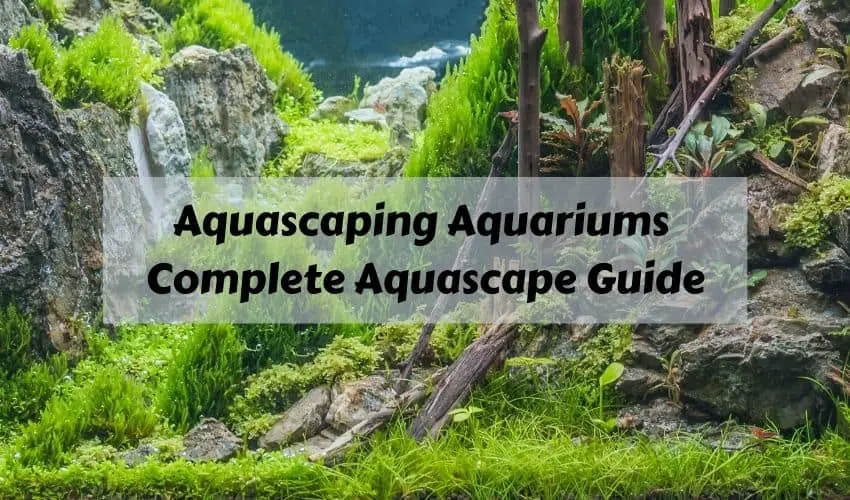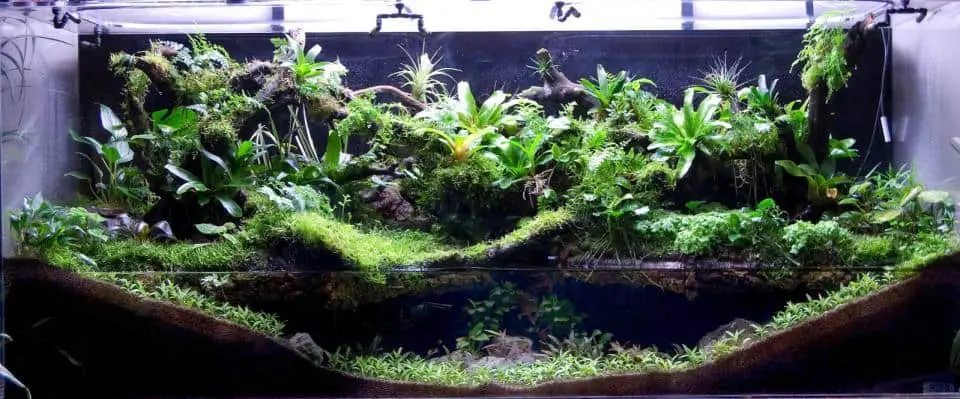Aquascaping Aquariums is the art and craft of decorating aquariums. Aquascaping involves building underwater landscapes. An aquascaper will fill the bottom of an aquarium with rocks and plant life, and decorate it beautifully. Some aquascapers also use their skills to decorate ponds instead of aquariums.
Table of Contents
Career In Aquascaping Aquariums
There is plenty of talent and artistry involved in the job as an expert aquascaper can create a gorgeous underwater landscape that is far above the usual standard. Aquascaping aquariums is similar to gardening, except done underwater. An aquascaper must design their aquascape well enough that the plants can thrive in the environment they create. The best aquascapers are respected and highly regarded artists that win aquascaping contests all over the world.
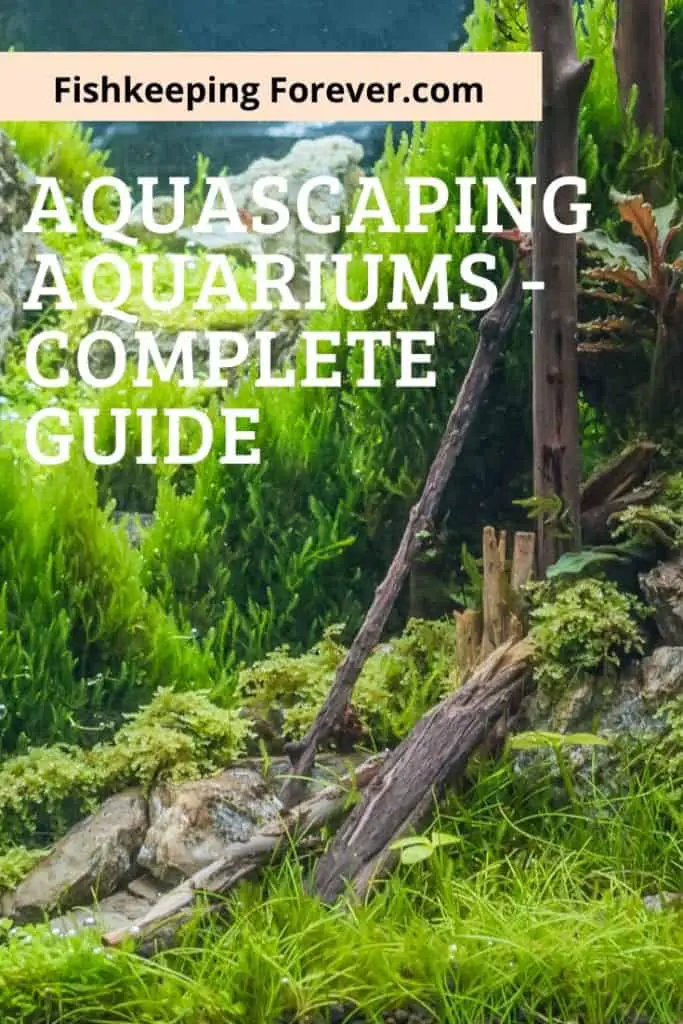
What To Consider When Aquascaping Aquariums
An aquascaper needs to understand lighting and how it affects plant growth, as well as how an artificial marine ecosystem works. While light is required for plants to grow, it also causes the growth of algae. Algae can grow to such an extent that it ruins an aquascape. Algae eating fish and other organisms are added to keep the algae down. The primary skill of an aquascaper is artistic, but knowing how to maintain the tank is essential as well.
Aquascapers need many different skills to keep their underwater ecosystem healthy. Aquascapers trim plants into suitable shapes and tie plants in place with cords that are not visible to the audience. An aquascaper also knows how to use fertilizers to keep their underwater garden healthy. Often, the soil at the bottom of the aquarium is laterite, which provides vital nutrients to the plants.
A Little History Of Aquascaping Aquariums
Aquascapers build aquariums in many different styles, the most well known of them being the Dutch style as well as the many Japanese styles. Aquascaping experts all over the world compete in aquascaping competitions, where they compete with the best in the world to create the most visually gorgeous underwater gardens.
Some say that aquascaping began in the 1930s; however, people were building less elaborate decorated aquariums in the nineteenth century and before. While aquascaping is not yet very well known, it is becoming more popular.
The video above shows you some of the best fish to add to an aquascaped aquarium. Fish that school in large numbers are always used to show off the effects of an aquascaped aquarium.
Types Of Aquascapes
The Dutch style
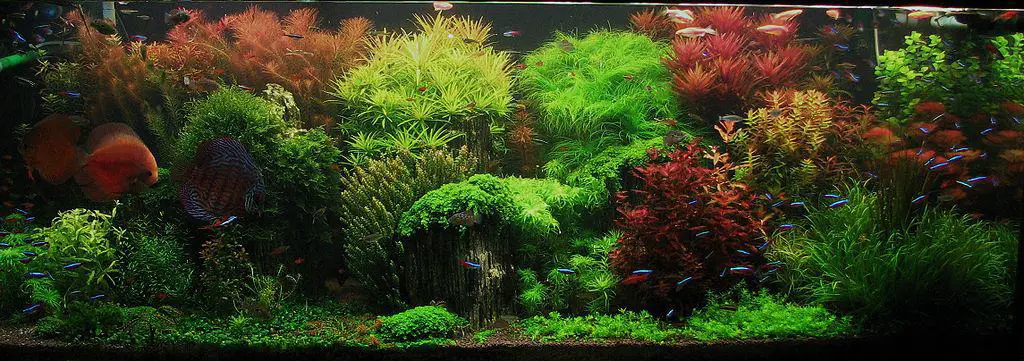
One of the most popular types of aquascape in the world, the Dutch style, involves many different kinds of plants with many different colors arranged to create an artistic landscape. The Dutch style is one of the oldest forms in the world, dating from the Netherlands in the 1930s. The Dutch style goes back to the beginning of the popularity of the craft, which began when freshwater aquarium equipment first became commonplace.
In the Dutch style, the emphasis is on plants, so wood and rocks are not the focus, and an aquascaper may omit these elements entirely. Aquascapers place plants on raised beds so that they are all at a different height. Dutch-style aquascapers place high importance on color, so exotic marine plants are used for their distinctive red, yellow, and orange colors. Aquascapers arrange plants into rows, which are known as streets.
The Japanese Styles
Nature style
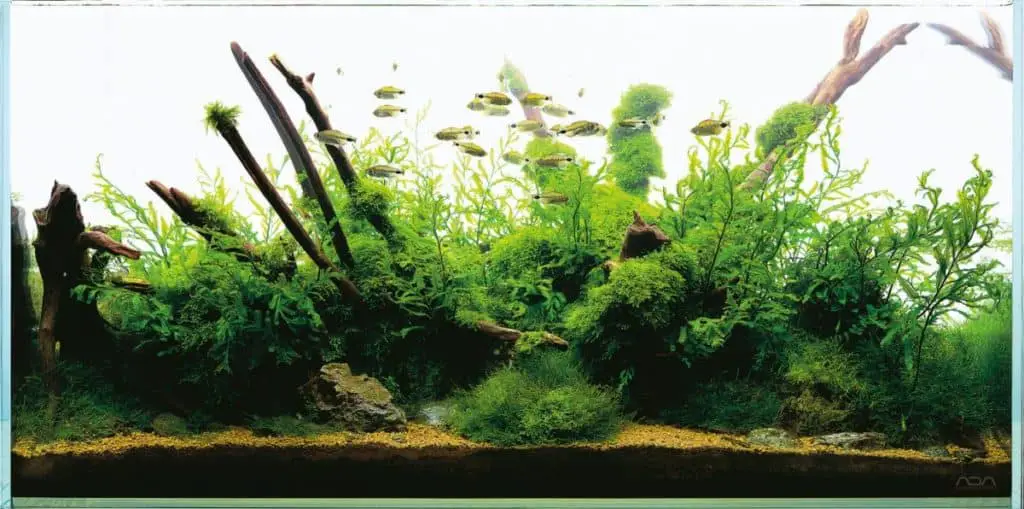
Unlike the Dutch style, the Japanese nature style creates a miniature model of a landscape. A nature style aquarium might resemble a forested mountain landscape with stones and plants arranged to resemble mountains. The nature aquarium style is relatively new, beginning in the 1990s. The distinctive nature style is inspired by Japanese gardening, even though the composition is intended to resemble a landscape rather than a garden, with the Dutch style being more likely to resemble a garden.
See some of the best fish to add to an aquascape aquarium here in our recent article. Click here!
Japanese aesthetic tastes heavily influence the nature style. The creator of the form, Takashi Amano, created the technique using the Wabi-sabi artistic concept. Wabi-sabi uses minimalism to create beauty. Unlike the Dutch style, a mossy look is typical in the Japanese nature style. While an aquascaper does not use actual moss, plants with small leaves mimic the appearance of moss.
Iwagumi style
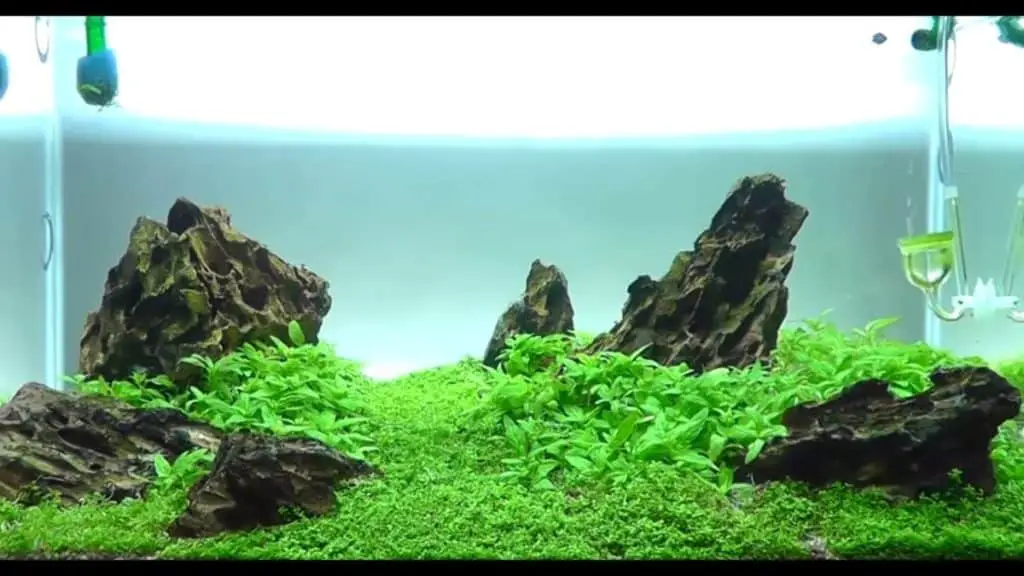
Originally part of the nature-style, the Iwagumi style has gradually changed into something distinctive. The method emphasizes the artistry of the rock formations more so than the plants in the aquarium. Usually, one large stone and two smaller stones are the foundation of the decoration, with more rocks and plants added as well. To a lesser extent than the typical nature style, the Iwagumi style often recreates natural terrain in miniature.
Taiwanese style

Although less popular than before, the Taiwanese style is still in use today. The Taiwanese method includes miniatures and other objects that are neither rocks nor plants to decorate the aquarium. Taiwanese aquascapers raise plants to different heights upon rock formations and add strange objects to decorate their aquariums further.
Biotypes
While most aquascapes mix different plants and animals from different geographic environments together, even though these plants and animals would never be in the same area in nature, the biotype style avoids this. Biotypes attempt to recreate the natural environment.
Only plants and animals that appear together in nature appear in biotypes. Not only the plants and animals but also the rocks and sediment must all appear together in a real location. Usually, biotypes include plants or animals, as is the case for other forms of aquascapes, but some biotypes only artistically arrange stones and silt, with no plants or animals present.
Paludariums
A paludarium contains a land component as well as a water component. This complexity can make a paludarium take longer to build than the other styles. A paludarium does not model a landscape in miniature like the Japanese techniques often do but still represents a specific geographic region. A rainforest, jungle, swamp, river’s edge, or sandy beach are common themes.
The rocks in part of the tank are high up enough that the landscape is partly above water, with much or most being below it. Plants that are on land but have roots that extend into the water are common for paludariums aquascapes. Floating plants at the surface of the aquarium water typically appear as well.
Saltwater Reefs
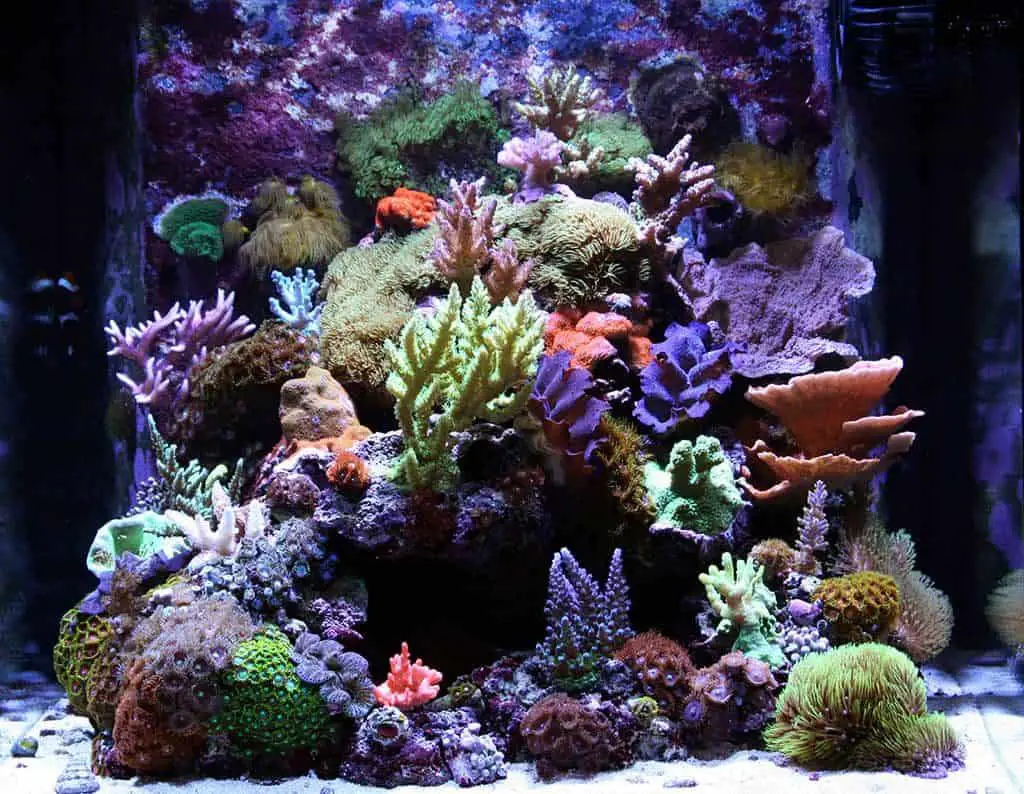
While aquascapes are usually freshwater environments, there are also saltwater designs. Saltwater designs are less popular because the variety of artistically pleasing plants that grow in saltwater is more limited.
Corals, small sea animals, and rock formations contribute to these designs. More commonly than in other styles, aquascapers intentionally allow algae to grow for artistic effect. Glowing microorganisms are also present in these tanks to enhance their beauty. Aquascapers must use intense lighting for the health of the life in these aquariums.
Walstad style
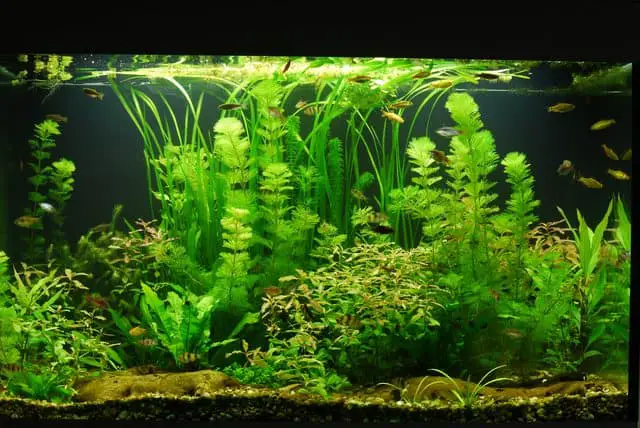
The Walstad style emphasizes randomness and puts a variety of different plants and animals into a tank in a seemingly careless arrangement. There can be beauty in the realism of scattering plants and stones together somewhat haphazardly, as this is more similar to what appears in nature. An aquascaper using the Walstad method does not focus on arranging the plants and decorations in the most beautiful way possible.
Instead, the Walstad method attempts to find beauty in a random, natural arrangement of plant life. It is easier to design and build an aquarium using the Walstad style, and so this style may appeal to those new to the craft, as they are not yet willing to spend a lot of time and money on a design. Walstad style aquascapes are also popular with amateur hobbyists because they are low maintenance. Aquascapes done in this style are not likely to win significant contests.
Aquascaping Competitions And Contests
The best aquascapers attract audiences from all over the world and travel to different locations to show off their crafts. Various aquascaping contests have different rules and specifications.
An aquascaping competition will specify the size of the tank that an aquascaper must use or the amount of fluid that the tank contains. Competition rules usually give aquascapers some choice in the size or volume of their aquarium, within some limitations.
Aquascaping contests began in the Netherlands, with 100 small clubs quickly appearing. The National Aquarium Society continues to host competitions in the Netherlands today, where aquascaping aquariums remains popular after all these decades.
The largest aquascaping contest in the world, however, is in Japan rather than the Netherlands. The Japanese IAPLC (International Aquatic Plants Layout Contest) is the largest and most prestigious of all aquascaping contests. The contestants do not have to move their tanks to Japan.
Instead, they submit photographs, which a panel of judges view. The 2017 competition had 27 different aquariums. The first, second, and third prizes went to Takayuki Fukada (Japan), Chao Wang (China), and Junichi Itakura (Japan). The top three aquariums were titled “Mighty Cave,” “Dreamland,” and “The rest of the dream.”
All three of the top submissions included above water as well as below water elements. Many of the other 27 submissions were entirely below water.
The World’s Greatest Aquascapers
One of the most influential aquascapers in the world must be Takashi Amano of Japan, who created the nature aquarium style back in the 1990s. His work appeared in the wall street journal back in 2012, bringing knowledge of aquascaping aquariums to more of the general public.
Takashi Amano has been working in the art world since 1975, when he was primarily a photographer who captured images of nature in South America, Japan, Borneo, and Africa. Today he still takes photographs, especially of the still plentiful Japanese forests. He is most famous for his aquariums, which may have had more influence on other aquascapers than the work of any other artist.
If Takashi Amano did more to influence the work of existing aquascapers than anyone else, Oliver Knott might have done more to bring new people into the art than anyone. Oliver Knott travels around the world, introducing aquascaping aquariums to the public in many countries and encouraging people to attempt to build aquascapes.
Felipe Oliveralia of Portugal also deserves a spot on this list for his work to make more useful information about aquascaping aquariums available to the general public. Felipe Oliveralia runs one of the best, if not the best aquascaping blog in the world, an excellent resource for those interested in the craft.
Also worth mentioning is Jeff Senske and Mike Senske of the United States. The two of them founded the influential Aquarium Design Group in 2000, intending to make aquascaping a better known and more prestigious art form. While people who make aquascaping aquariums into a profession are still uncommon, the two of them run a custom aquarium design business.
A Complete Guide To Building Aquascapes
While the lengthiest aquascaping design projects can go on for years, building a good aquascape is not a daunting task. Some people can do reasonably well on a first try, depending on their talent for the art form. Start with a project that is advanced enough that you will remain interested in it and not become bored with the project.
It is not necessary to build something too minor the first time around. One should not, however, expect to be able to create something as impressive as those who have been making aquascapes for years or decades.
Before one begins aquascaping aquariums, they need to have proper tools. Using typical household and garage tools is not a good idea and will slow down and reduce the quality of your first project. Use the right tools for the job. Amazon.com sells sets of special scissors and scrapers that are used by aquascapers. These tools are quite different from and work much better than ordinary scissors.
After purchasing the tools, you are going to need plants and other decorations. Aquascapers can order plants for aquariums on Amazon as well. You may also buy driftwood if your plan calls for it.
For your first project, you might want to look at a picture of a reasonably simple aquascape design and then significantly modify it to create something original. Starting without a plan may result in you abandoning the whole project. Have some fun with it, and don’t get discouraged if it does not go very quickly. A first project that can impress your friends and family is realistically achievable.
Here’s a great article with a step by step timeline and photos.
Before you begin building your aquascape, you must make sure that your aquarium is a place where your plants and fish can survive. Without the right lighting, substrate, carbon dioxide, and fertilizer, your plants will not be able to survive in your aquarium. You must create a habitable water environment before you can build your aquascape.
Once you have all of your tools, plants, decorations, substrate, and a habitable environment, you can start building your aquascape, as long as you have a plan in mind.
Choose the best aquascaping aquarium substrate before you start. Read our guide here!
Symmetry is something to avoid at least most of the time in aquascaping aquariums. There can be some beauty in symmetry, but symmetrical aquascapes are not beautiful. The aquascapes are inspired by the natural terrain, which is asymmetrical. Artists know that the focal point should be somewhat away from the center, and not in the exact center or in one of the corners.
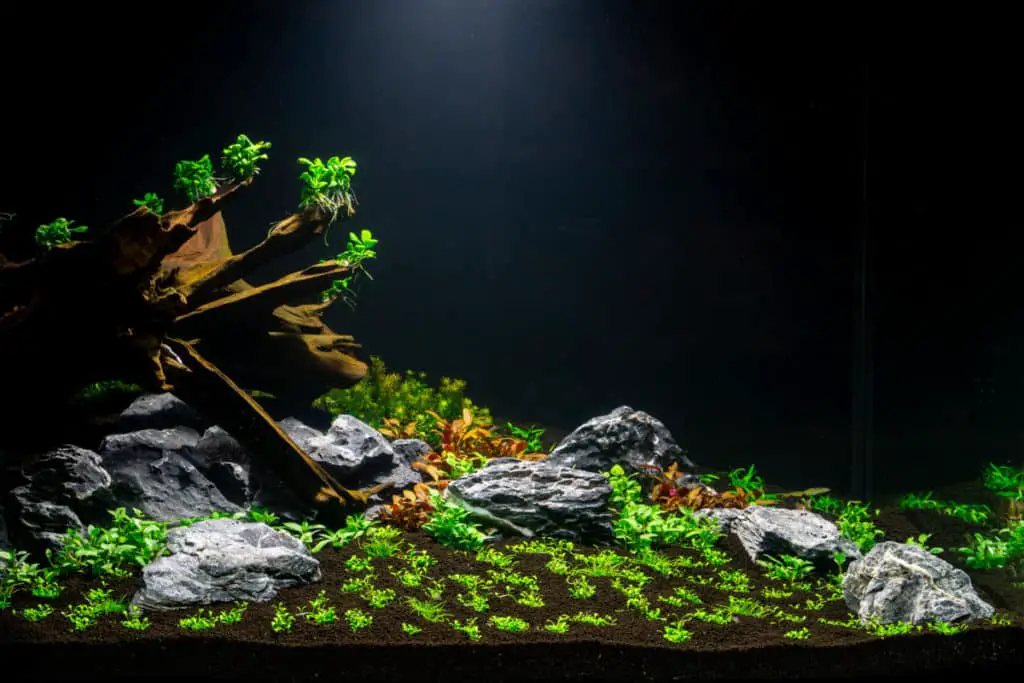
The shape of the display should be attractive. Having high plants arranged along the back of the tank is not good. The plants should vary in height. By making the plants different in height, you can create a curve or even a triangle. With a triangular shape, you can create an island theme where some of the plants are above water on one side of the tank, with most of them below water.
While an aquascape should have a theme and a style, you should not use only one type of plant or very few types of plants. A single color that dominates with other colors being present is a good idea. Part of the artistry is to leave a reasonable amount of open space. Packing your aquascape with too many plants will make it look cluttered.
If you are building a mountain-shaped design, do not place the mountain in the exact center – this is not artistically sensible. Instead, position the mountain somewhat away from the center of the tank.
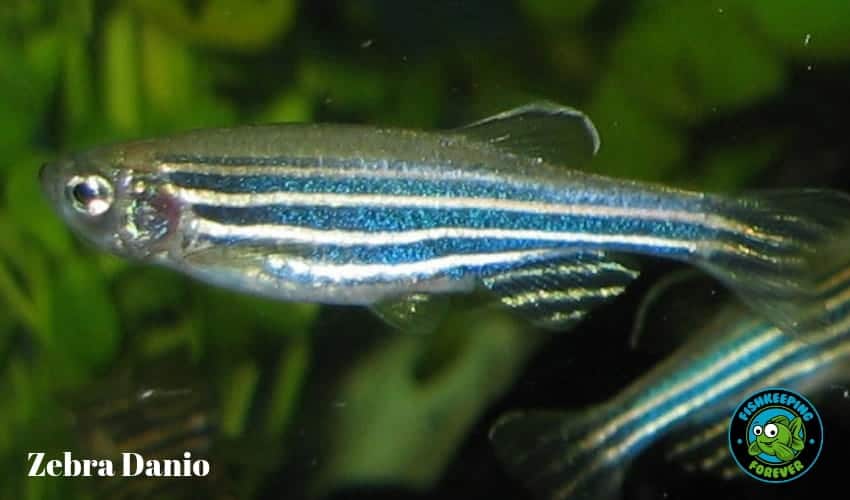
Once you have a good plan in mind and your rocks in place, it is time to start planting the tank. Start at the background and then move forward. If you put plants in one at a time at random, then you may end up having trouble finishing your project. You will usually have to tie the plants to the rocks to get them to stay in place. Use a type of cord that can resist the water without falling apart over time.
Add moss as well, as your rocks will make your tank look barren without it. Give the plants time to grow in. You have a reasonable chance of building something impressive on your first try.
Depending on what you are trying to create, you might want fish, clams, shrimp, or other sea life as well. Small fish that swim in schools are one of the more popular choices. In a large aquarium, perhaps a hundred of them are not too many. Brightly colored fish is a good idea. Not everyone uses fish or any other animals, but they can help your tank stand out.
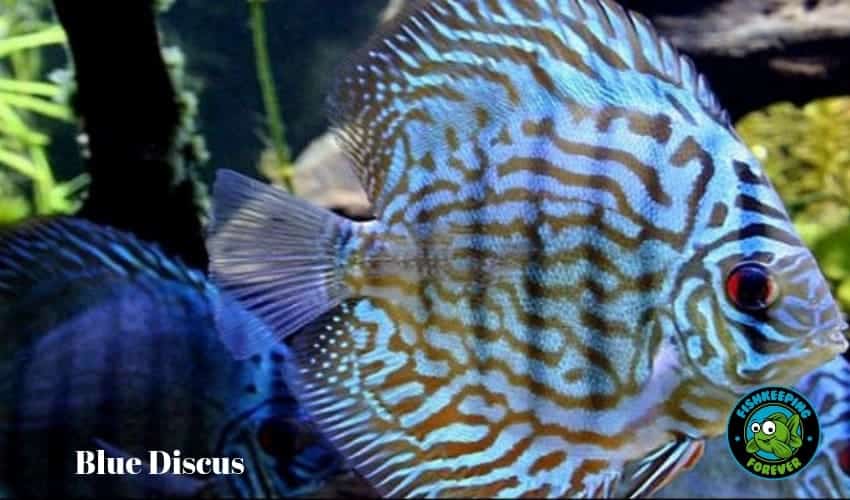
Final Thoughts: Aquascaping Aquariums
It is essential to avoid becoming frustrated during your first project. Make sure that you plan what you are doing in advance. You will have to finish several early steps before you begin adding plants and fish to your aquascape.
Make sure that you have the tools, most or all of the plants and decorations you are going to use, a well lit and fertilized tank that plants can grow in, and a solid plan before you begin building.
A first tank will not be good enough to win any contests, but you can have fun with it, impress your friends, and learn a new hobby with aquascaping aquariums that you might continue to practice for a long time.
- Best Aquarium Plant Substrate Review 2022
- 18 Benefits of Marimo Balls ( How many per Gallon? )
- 11 Best Plants for Betta fish
- Top 7 Best plants for baby fish
- 9 Best Plants for Guppies ( Freshwater Aquarium Plants )

I have been working in the tropical fish industry for over 30 years now and I’m still learning. Everyday is a school day in this hobby. In my spare time I play golf very badly!


